For some reason, I found myself baking a lot of birthday cakes this summer. Specifically, I made two carrot cakes and two red velvet cakes. Based on this staggeringly high output, I now consider myself an expert on the subject, which means nothing really, but any chance I get to call myself an expert on something is celebration enough (for me). This all is my way of saying that in my EXPERT opinion, you all should make these cakes.
First, we have a carrot cake. Technically, it’s Ina Garten’s carrot and pineapple cake. Here’s what you need to know: this will be the very best carrot cake you will ever make. I’ve made it twice now (and once another time), and it has been stupendous. Seasoned carrot cake fans such as my dear friend Sly will attest that it is the best carrot they’ve ever eaten. This is no joke, people While Ina Garten may be known for her Beatty’s Chocolate Cake recipe, it’s this wonderful carrot masterpiece that should be the crown jewel in her dessert empire (I’ve made both, and I say it with authority — although, the chocolate cake is delicious too).
And then we have the red velvet cake. This beloved cake is a bit of a tricky beast to master — I think we’ve all taken bites of our fare share of dry, crumbly versions. But I’m happy to report that the recipe I’ve found online delivers a moist, flavorful cake that will please even the snobbiest of red velvet fans.
Pics of the cakes after the jump…

First, let’s start with the carrot cake. Before we do anything, I’m sure to bring the cream cheese and eggs up to room temperature. The former item will be used to great effect in my world famous cream cheese frosting recipe.

Apron on, selfie ready.

Standard cake-making steps here: gotta butter some pans, throw in some parchment paper, and butter those too.

Carrots. We all know how this ends.

Don’t let those carrots fool you. Things quickly turn unhealthy with the arrival of one and a third cups of canola oil. And, you know, two cups of sugar.

The sugar and the oil and those eggs from before get whipped together violently until the mixture turns light yellow and ribbony. It’s pretty intense.

And there we go. There’s vanilla in there too.

In another bowl I mix the dry ingredients: flour, cinnamon, baking soda, and salt.

And now the happy marriage of wet and dry.

Essential mix-ins: walnuts and raisins. They’re coated with flour to prevent them from sinking to the bottom of the batter.

Behold: pineapple.

Remember that carrot? I just grated it in the food processor.

Orange you glad you read this post? (to be clear, we’re still looking at carrots, not oranges)

The carrots, raisins, walnuts, and pineapple all come together. At this point we basically could stop here and serve up a lovely carrot salad.

Finally, er’rything gets mixed together, and thus we achieve complete carrot cake batter status.

Into the pan goes the batter. And into the oven go the pans. Circle of life (although, it’s actually pretty linear in this case).
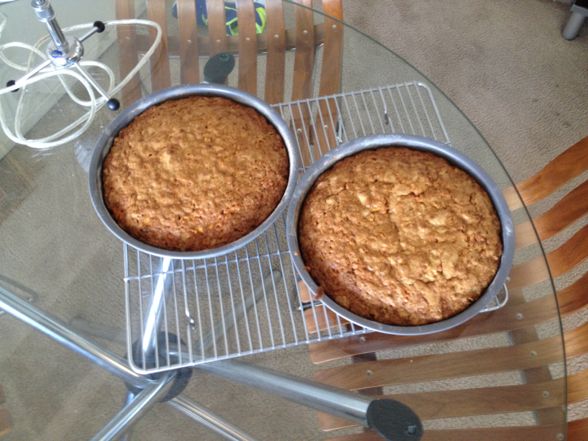
About an hour later, we have cake rounds.

Now onto the frosting. This is actually Ina Garten’s cream cheese frosting recipe, which calls for way too much butter. It detracts from the cream cheese. Hence, why I created my own version, which I’ve used ever since.

Time to get mixing.

Just a scant box of powdered sugar joins the cream cheese and butter and vanilla extract. No biggie.

Final product.

Even though Ina’s recipe calls for too much butter, it’s still super tasty.

And now the assembly. With a little luck, I’m able to slip the first round out of the pan.
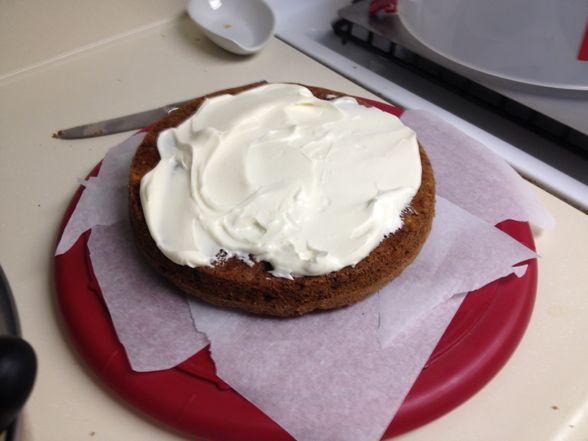
So far, so good.

Round #2 is in place.

Ta-da!
Later that day…

DOH!
As for the red velvet situation, I can assure you it followed a similar trajectory, courtesy of Divas Can Cook:

We once again begin with dry ingredients. This time they include flour, baking soda, baking powder, salt, and cocoa powder. The recipe calls for just a scant 2 tablespoons of cocoa. The second time I made the cake, I doubled it for a more chocolate-y flavor.

Our wet ingredients: two cups of sugar and one cup of canola oil. Again, another healthy situation unfolding here.
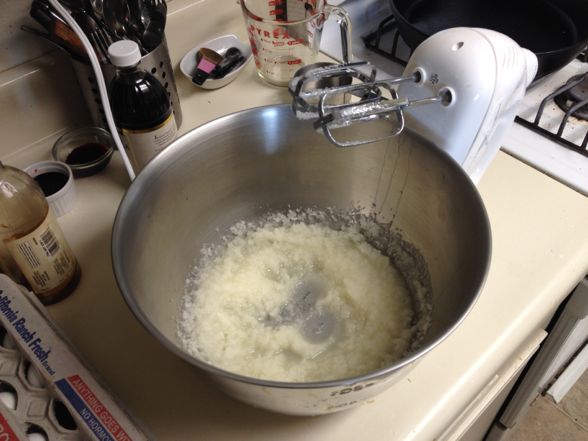
The oil and the sugar become fast friends.

Well, this recipe may call for less oil than the carrot cake, but we make up for it by adding in a cup of buttermilk. Also eggs and red food coloring. It looks not unlike someone just slit their wrists over the bowl.

Ultimately, I combine everything together for an electrically red batter that goes into the oven for about 35-40 minutes.

Eerie reminders of the batter remain.
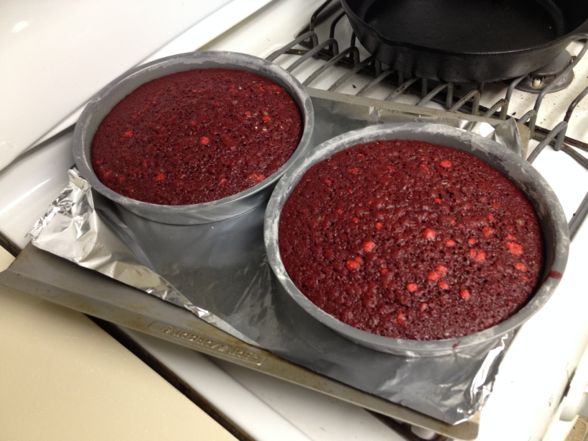
Soon we have two impossibly moist cake rounds.
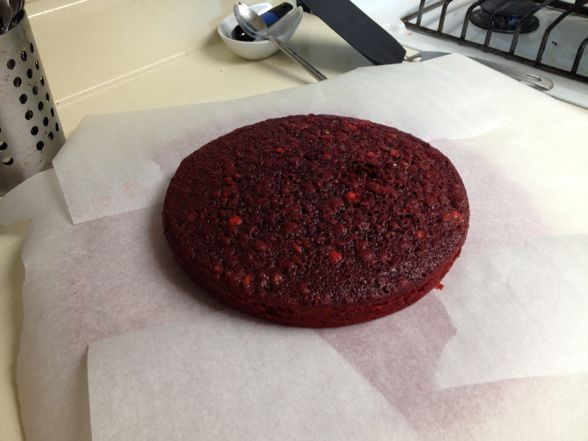
Time to frost, this time with MY cream cheese frosting.
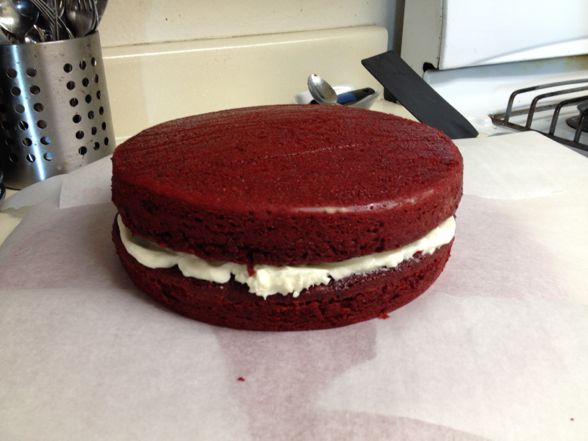
I’m tempted to pick up this oversized whoopie pie and take a huge bite out of it.
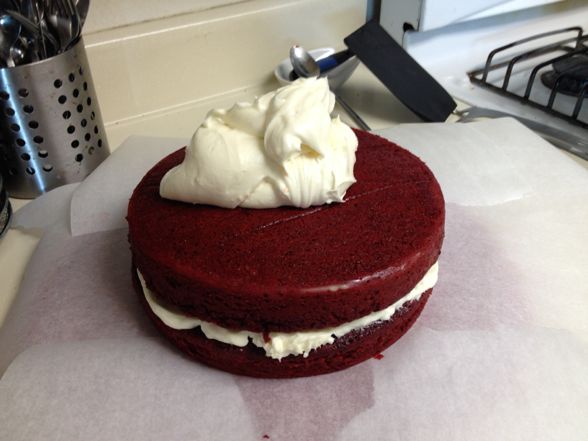
Instead, I apply more frosting.

Looks messy, but don’t worry. It’ll clean up real niiiice.

Well, sort of nice.

Clearly, the cake was appreciated.

My first ever red velvet cake: total success!
And here’s the red velvet cake process in motion, courtesy of Vine:
The Verdict?
I think you know what I’m going to say. Delicious! I mean, the carrot cake is a showstopper. Truly excellent. The red velvet cake is also great and perfectly moist. My only complaint the first time around was that the chocolate flavor was subtle at best. Doubling the cocoa for the second cake definitely helped, but even then it could use another chocolate boost. Either way, it was nothing that really got in the way of the enjoyment of the cake — it just messed with expectations. Both cakes should definitely be part of your cake-making repertoire (although, if you make just one, it should be the carrot cake).
Oh, and whatever you do, be sure to use my recipe for the cream cheese frosting. It makes all the difference.
• Carrot and pineapple cake by Ina Garten
• Red Velvet Cake by Divas Can Cook


maybe if you used ‘the best dutch process cocoa’ and ‘good’ vanilla, you’d have been more pleased by the amounts called for.